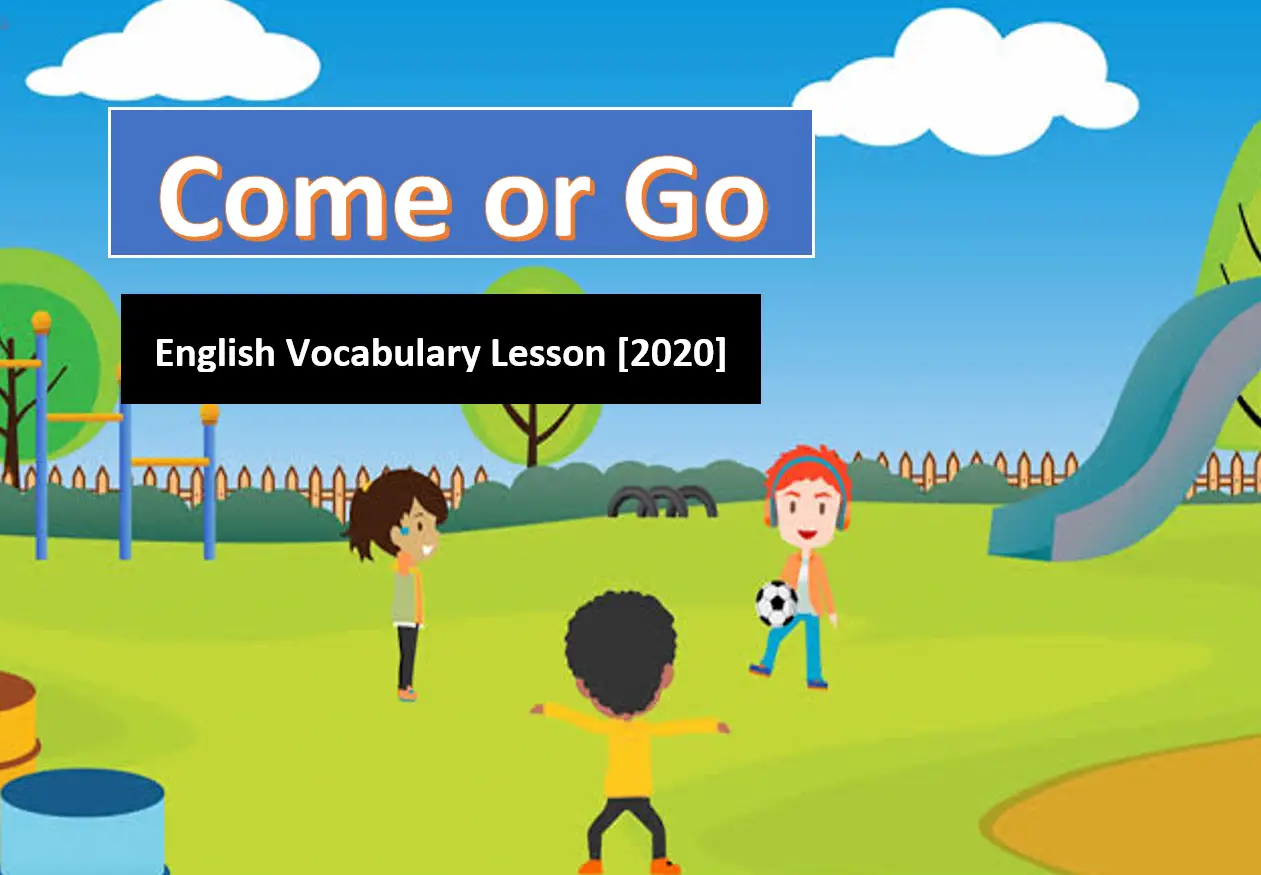Come vs Go – English Vocabulary Lesson
In this tutorial about Come or Go – English Vocabulary Lesson for beginners, learners would Learn English Fast when to use the verbs COME vs GO. This Come or Go grammar tutorial also comes with exercises and video to teach learners more efficiently.
Come is used for movements to the place where the speaker or hearer is or was or will be and GO is used for movements to other places. Both come and go describe movement from one place to another place.
Watch the Come or Go English Grammar Tutorial Video here:
Come VS Go Comparison
Let us discuss first the verbs “come” and “go” to determine well when to use them. As you read through this, you will fine some Come or Go Grammar Exercises that are ideal for you.
Come /kuhm/ verb past simple – came
Past participle– come
I’m coming to the village.
Go /ɡəʊ/ verb past simple – went
Past participle– gone
I’m going to the village.
When do we use “come” and when do we use “go”?
Answer: It depends on the position of the speaker or hearer.
Here are the definition and usage of Comer or Go English Grammar:
We use Come;
1. For movements towards the speaker.
Sharon (speaker) is in a beauty parlor. Jack is at the market. Sharon calls Jack. Sharon: Please come to the beauty parlor.
2. For movement towards the hearer
Jack: “Ok, I’m coming to the beauty parlor”.
We use Go;
1. For movement Not towards the speaker.
Sharon and Jack are both at the beauty parlor. Sharon (speaker) is talking to Jack. Sharon: Please go to the bakery shop and buy some bread.
2. For movement NOT towards the hearer.
Jack: Ok, I’m going to the bakery shop.
Let’s look at some more examples:
Here are more Example to look at to add knowledge about come or go Grammar Tutorial (Come vs Go Examples)
Come- More examples
1. For movements towards the speaker we use “come”
Sharon is in the living room. Jack (speaker) is in the kitchen. He needs help.
Jack: Please come to the kitchen I need your help.
Jack: Please go to the kitchen I need your help. X
For movements towards the “hearer”, we also use “come”
Sharon: Ok, don’t panic! I’m coming.
Sharon: Ok, don’t panic! I’m going. X
Come- More examples
1. For movements towards the speaker we use “come”
Jack is at school. His mother (speaker) is at home.
Mother: Jack, where are you?
Jack: I’m at school.
Mother: Please come home immediately. /
Mother: Please go home immediately. X
2. For movements towards the “hearer”, we also use “come”
Jack: Ok, I’m coming. I’ll be there in 20 minutes. /
Jack: Ok, I’m going. I’ll be there in 20 minutes. X
Go- More Examples
1. For movement Not towards the speaker, we use “go”.

2. For movement Not towards the speaker, we use “go”.

For movement Not towards the hearer, we also use “go”.
Jack: Ok, I’m going.
Jack: Ok, I’m coming.
Past Tense
If the movement is happening in the past:
The position of the speaker and hearer in the past is important.
The position of the speaker and hearer in the present is NOT important.
We use “come” for the movement towards the speaker and hearer in the past.
Yesterday (past) Sharon had a birthday party in her house.
Today (present) Sharon (speaker) and Nicole are talking in the school.

Future
If the movement is in the future:
The position of the speaker and the hearer in the future is important.
The position of the speaker and hearer in the present is not important.
We use “come” for movements towards the speaker and hearer in the future.
Sharon (speaker) and Nicole are talking inside the classroom.

Future Tense – Another Examples:
Sharon (speaker) and Jack are talking in the classroom.
Sharon: I’m having party at home tomorrow. Do you want to come?
(anticipated movements towards the speaker in the future)

Jack: No, Sorry. I’m going to a tennis match tomorrow.
(the movement is not towards the hearer in the future)
Summary
Come
1. For movement towards the speaker.
Sharon: “Please come to the Salon”
2. For movements towards the hearer.
Jack: “Ok, I’m coming to the salon”.
Go
1. For movements NOT towards the speaker.
Sharon: “Please go to the newsstand and buy a magazine.”
2. For movement NOT towards the hearer.
Jack: “OK, I’m going to the newsstand”.
Come or Go Grammar Exercises 1
Choose between come or go and write your answer on the blank.
1. John wants to __________ out with Sam.
2. Marie, please __________ back! I’m sorry.
3. Here’s the restaurant. Let’s __________ in.
4. __________ in and sit down.
5. I’m fed up. Let’s __________ out for a coffee.
6. Ah, there you are! __________ in and have a seat!
7. We__________ from Venezuela.
8. __________ on, we’re late!
Come or Go Grammar Exercises 2
Choose between come or go and write your answer on the blank.
1. Do you want to __________ out with me tonight?
2. __________ over to my apartment.
3. We want to __________ home, it’s late!
4. __________ and see this!
5. I need to __________ to the dentist’s.
6. the answer __________ to me yesterday.
7. Spring has__________ early this year.
8. He isn’t here. He has __________ shopping.
Downloadable Materials
Here’s the downloadable materials of Come or Go – English Vocabulary Lesson.
Related Article
- Prepositions of Time IN, ON and AT- English Grammar
- Prepositions of Place: AT, IN, ON English Grammar Tutorial
- When To Use “Do” and “Make” In English Grammar Lesson
- How Much VS How many – Countable and Uncountable Nouns – Food
- Past Simple Tense ‘TO BE’- Was/Were
Inquiries
If you have any questions or suggestions about Come or Go – English Vocabulary Lesson, please feel free to leave a comment below.


